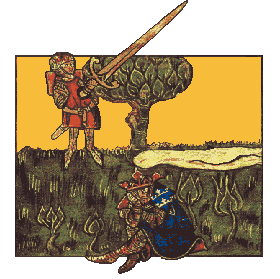 |
 |
|||
|
|
The Tradition: The Name "Excalibur" was first used for King Arthur's sword by the French Romancers. It was not the famous "Sword in the Stone" (which broke in battle), but a second sword acquired by the King through the intercession of his druidic advisor, Myrddin (Merlin). Worried that Arthur would fall in battle, Merlin took the King to a magical lake where a mysterious hand thrust itself up from the water, holding aloft a magnificent sword. It was the Lady of the Lake offering Arthur a magic unbreakable blade, fashioned by an Avalonian elf smith, along with a scabbard which would protect him as long as he wore it. Towards the end of his reign, during the troubled times of Medrod's rebellion, Excalibur was stolen by Arthur's wicked half-sister, Morgan le Fay. Though it was recovered, the scabbard was lost forever. Thus Arthur was mortally wounded at the Battle of Camlann. The King then instructed Bedwyr (or Girflet) to return Excalibur to the lake from whence it came. However, when questioned about the circumstances of its return, Bedwyr claimed to have seen nothing unusual. Arthur therefore knew that Bedwyr had kept Excalibur for himself and sent him back to the Lake once more. Hurling the sword into the misty waters this time, Bedwyr saw the mystic hand appear to catch Excalibur and draw it beneath the rippling waters for the last time. The Name: The earliest Arthurian stories give the name of King Arthur's sword as Caladfwlch, a Welsh word derived from Calad-Bolg meaning "Hard Lightning". Later it developed to become the Caliburn of Geoffrey and Monmouth and finally the Frenchified Excalibur that we know today. Ancient Origins: Legendary figures throughout the World are associated with magical swords, often the symbol of their Kingship. It is interesting to note that Curtana, a 17th century successor of the original sword of Ogier the Dane, is still used at the British Coronation to this day. King Arthur's tale has particular similarities to the Norse Legend of Sigurd, but even closer parallels can be drawn with the Irish hero, Cú Chulainn who also bore a sword named Caladbolg. Such swords were usually said to have been forged by an elfan smith. In Saxon mythology his name is Wayland, but to the Celts he was Gofannon. He is also to be identified with the Roman Vulcan and Greek Hephaestus who made magical weapons for the Muses to give to Perseus, and for Thetis to give to Achilles. The later surrender of the sword is well known as a universal symbol of defeat. Here it is emblematic of death itself. The deposition of swords, weaponry and other valuables in sacred lakes and rivers was a popular practice amongst the Celtic peoples. Strabo records such rituals near Toulouse and notes that other sacred lakes existed throughout Europe. Gregory of Tours alludes to a three-day festival of deposition at Lake Gévaudan in the Cevennes. Some scholars believe that such rituals were part of Celtic funerary rites. Archaeolgical finds of exotic metalwork deposits at Llyn Fawr in Morgannwg include axes and sickles of around 600 bc. Further weaponry was discovered Llyn Cerrig Bach on Ynys Mon (Anglesey) dating from the 2nd century bc to the 1st century AD. Celtic Iron-Age deposits in rivers are too numerous to count. Especially well known are the superb Battersea Shield and Waterloo Helmet from the Thames. This major British River appears to have been particularly popular for swords like Arthur's.
|
|||
| © Nash Ford Publishing 2001. All Rights Reserved. | ||||



 Arthur's Sword
Arthur's Sword